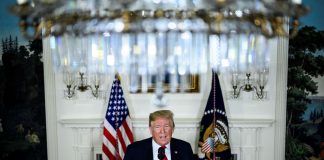MARCH 11, 2019
 A congressional staffer holds up a copy of volume one of President Trump’s budget for the fiscal year 2020. The budget is considered dead on arrival in the House, which is led by Democrats. (Michael Reynolds/EPA-EFE/Shutterstock)
A congressional staffer holds up a copy of volume one of President Trump’s budget for the fiscal year 2020. The budget is considered dead on arrival in the House, which is led by Democrats. (Michael Reynolds/EPA-EFE/Shutterstock)
President Trump unveiled his 2020 budget Monday that basically has no chance of getting enacted. Even Republicans balk at some of Trump’s proposed cuts.
But the 150-page budget reveals a lot about Trump’s top priorities as his reelection campaign gets into full swing, and he looks to make it clear there are big differences between his vision for America and that of his Democratic rivals. In short, Trump wants more spending on the military and veterans and less spending on education, housing, welfare, transportation and science.
Here are the top 10 takeaways from Trump’s “Better America” budget:
1. Big deficits are here to stay. Despite proposing the “most spending reductions ever sent to Congress,” as one of Trump’s top aides put it, the deficit is expected to hit $1.1 trillion this year and stay above the trillion mark every year through at least 2022. This is unprecedented in good economic times and is occurring because Trump and Congress are spending more at the same time the GOP tax cuts drive down government revenue. (Trump’s budget shows small increases the next few years in tax revenue, but that might be a stretch given what is occurring so far this fiscal year).
2. Trump predicts no recession — for a decade. No president likes to predict a downturn, but Trump is being exceptionally rosy in his outlook. His budget predicts about 3 percent growth for a decade. In contrast, the nonpartisan Congressional Budget Office predicts growth of slightly below 2 percent. To achieve Trump’s projection, the economy would have to grow at A-plus potential for years with no recessions, something the United States has not achieved before.
Consider just this year and next: Trump’s budget forecasts 3.2 percent growth this year — almost a full percent above the Federal Reserve’s 2.3 percent prediction. In 2020, the vast majority of economists think growth will be around 2 percent (and some even say the United States will dip into a recession), but Trump’s budget predicts 3.1 percent growth.
3. The biggest winners: military and veterans. Trump’s budget gives the Defense Department a nearly 5 percent raise and the Department of Veterans Affairs and Department of Homeland Security (which includes border policing) each get about a 7.5 percent hike. NASA also sees a small increase as Trump looks to start a military space force and do more development in space.
4. The biggest losers: Under Trump’s budget proposal, 10 major departments and agencies would see their budgets slashed by 10 percent (or more) in the next year alone: Agriculture, Education, Energy, Health and Human Services, Housing and Urban Development, Interior, State, Transportation, Corps of Engineers and the Environmental Protection Agency.
The Trump administration likes to refer to a 5 percent cut in nondefense spending, but some agencies get far bigger chops than others. The EPA and Corps of Engineers would lose almost a third of their current funding.
5. Hot button issues: Trump wants $8.6 billion for border wall and fewer people on “welfare.” As expected, the president requested a substantial amount of money for expanding the border wall between the United States and Mexico. In fact, he asks for even more money in this budget than the $5 billion he wanted in December and ended up partially shutting down the government for over a month to try to get.
Trump also wants to implement controversial policies to require more people receiving government benefits such as Medicaid, SNAP and housing vouchers to find work or actively search for jobs. Many advocates for the poor say stringent regulations are already in place, but the Trump administration wants to go further and it’s calculating it can save a lot of money by doing so (e.g. saving $220 billion over the next decade on SNAP and over $20 billion on TANF, Temporary Assistance for Needy Families).
6. Cut Medicare by $845 billion. Trump promised on the campaign that he would not touch Social Security or Medicare, but he uses this budget to propose a major cut to Medicare. Trump wants to “reduce wasteful spending” on Medicare by expanding the list of treatments that require prior authorization before the procedure can be done and putting medical providers on notice who charge more than others. The administration argues these cost savings will help ensure Medicare can last for many years to come, but some argue it will result in people who need treatment having it delayed or not receiving it because of extra paperwork and hurdles.
7. Child care and paid parental leave. Trump touts his plans to help working parents by providing more money to make child care affordable and to start the first paid parental leave policy in the United States. He proposes a one-time $1 billion “competitive fund” to help underserved populations and spur more companies to launch child-care programs of their own.
As for paid parental leave, the budget includes no detail of this plan. A senior administration official told reporters that was deliberate to allow Congress to craft the best policy and send it to the president. The budget includes just $1 billion a year in federal dollars for paid parental leave, a fraction of what most say it would cost to launch a viable program.
8. States would have to take more responsibility (and pick up some costs). Under Trump’s plan, state governments would play a larger role in crafting policies. For example, much of Medicaid, the low-income health program, would become “block grants” so states get a lump sum amount from the government and then have to figure out how to spend it effectively. The net result would be a $241 billion reduction in Medicaid spending over the next decade for the federal government.
9. Lots of higher fees. Trump would like to double the H-1B visa fee (among other immigration fees), increase customs fees, create a “spectrum license user fee,” create a new e-cigarette user fee, create and increase various USDA inspection fees, etc. Many of these revenue streams go to support other programs Trump wants or to update computer systems.
10. Major changes to student loans. Trump wants to do away with the Public Service Loan Forgiveness program that pays off student loans for people who enter various government jobs. His budget calls for streamlining the student loan repayment system and having colleges and universities “share a portion of the financial responsibility associated with student loans.” The details are thin on how all of that would work, but Trump banks on his various changes to student loans saving the federal government $207 billion over the next decade.
Courtesy/Source: Washington Post










































































































